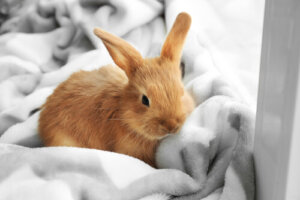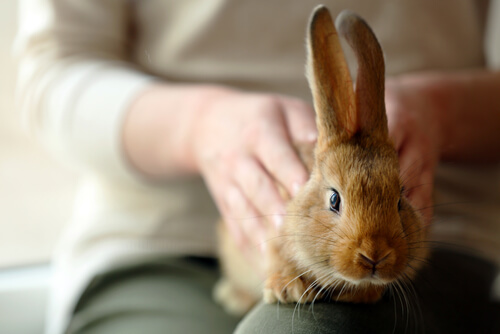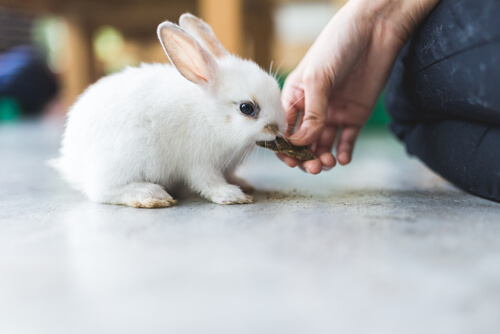Dwarf Rabbit Care Advice

Some people have pets that are a little more original than others, as is the case with dwarf rabbits. If you’d like to adopt one to be your companion at home, then we highly recommend that you read the following article. We’ll tell you all about the most important basic dwarf rabbit care advice, along with information about their physical characteristics and behavior. Don’t miss it!
Dwarf rabbit characteristics
The term dwarf rabbit refers to any lagomorph of the species Oryctolagus cuniculus domesticus that has a dwarfing gene or is smaller than normal. As studies indicate, the genetic variation that causes dwarfing is found in the HMGA2 allele, although not all smaller rabbits share this trait.
Although the size of dwarf rabbits vary according to the standard implanted, the following general requirements can be cited:
- The American Rabbit Breeders Association (ARBA) estimates that the weight of the smallest dwarf rabbits (the Netherland Dwarf) should be between 0.5 and 1.6 kilograms.
- However, the British Rabbit Council estimates a maximum weight of 1.1 kilograms. Other sources place the upper limit at 2.5 kilograms.
Dwarf rabbit care advice
As a first step, you should keep in mind that although dwarf rabbits require less attention than a dog, they also need our attention and care. As owners, we have to be responsible and offer them everything they need.
Dwarf rabbits are an excellent pet because they’re very clean and, in addition, due to their small size they don’t require large areas. Among the basic dwarf rabbit care, we recommend the following:
1. Don’t bathe them
As with cats, dwarf rabbits take care of their own personal hygiene. However, sometimes it may be necessary for you to help them a little (for example, if they get muddy in the garden). In that case, pass a towel moistened with warm water (don’t add soaps or cleansers) over their body very carefully.

2. Brush their fur
Besides being an activity that improves the relationship you have with your pet (which should be carried out from an early age in order for them to enjoy it), brushing them every day, or every other day, avoids the formation of hairballs.
Some dwarf rabbits have very short fur and it isn’t necessary to brush them so often. However, you certainly should do it during the molting season, that is to say, in spring and autumn. Don’t forget that if a hairball forms in their stomach, they may suffer health problems.
If they have long hair… don’t what ever you do cut it! It protects them from external elements such as cold temperatures.
3. Keep their cage in good condition
Another basic care for dwarf rabbits is related to their home. The cage should always be dry and clean, otherwise they’ll be likely to catch some diseases (mainly fungal or bacterial).
In turn, you should keep in mind that the size of the cage is paramount, even if the animal doesn’t grow any bigger. It should allow it to move freely, be in a cool and ventilated place, and receive some sunlight, but not too much. And, of course, they should have a place to shelter (like they would in their burrow) to escape from excess heat or cold.
4. Feed them correctly
The veterinarian will tell you what type of food you should give your dwarf rabbit. Mainly, the diet of these mammals should be alfalfa, carrots, fennel, hay, and also special feed.
It’s very important to respect the recommended amounts of food for rabbits, as they can be prone to obesity, especially when they don’t leave their cage too much.
Don’t forget to give them clean, fresh water daily and to clean their food and water bowls well to avoid bad smells, insects, and the proliferation of diseases.
5. Pay attention to their nails and teeth
A dwarf rabbit’s food must allow them to file their teeth, which never stop growing. That’s why experts recommend giving them ‘hard’ food such as feed or carrots. If you notice that their teeth are too long and are bothering them, then take them to the vet to have them filed. Do the same if their nails get too long.

6. Let it out of its cage
Some people take their dwarf rabbit for a walk as if it were a small dog. If you want to do the same, always take them on a leash and somewhere they can’t run away and get lost.
It’s better if you let them loose in the house, allow them to investigate the rooms, and then let them explore the garden, balcony, or patio. When they’re used to those areas, you can even take them to the park on the lead but be careful of dogs, especially breeds that are typically hunters.
Dwarf rabbits are very intelligent and have become a perfect pet for small homes with children. They’re sure to become your children’s best friend!
Some people have pets that are a little more original than others, as is the case with dwarf rabbits. If you’d like to adopt one to be your companion at home, then we highly recommend that you read the following article. We’ll tell you all about the most important basic dwarf rabbit care advice, along with information about their physical characteristics and behavior. Don’t miss it!
Dwarf rabbit characteristics
The term dwarf rabbit refers to any lagomorph of the species Oryctolagus cuniculus domesticus that has a dwarfing gene or is smaller than normal. As studies indicate, the genetic variation that causes dwarfing is found in the HMGA2 allele, although not all smaller rabbits share this trait.
Although the size of dwarf rabbits vary according to the standard implanted, the following general requirements can be cited:
- The American Rabbit Breeders Association (ARBA) estimates that the weight of the smallest dwarf rabbits (the Netherland Dwarf) should be between 0.5 and 1.6 kilograms.
- However, the British Rabbit Council estimates a maximum weight of 1.1 kilograms. Other sources place the upper limit at 2.5 kilograms.
Dwarf rabbit care advice
As a first step, you should keep in mind that although dwarf rabbits require less attention than a dog, they also need our attention and care. As owners, we have to be responsible and offer them everything they need.
Dwarf rabbits are an excellent pet because they’re very clean and, in addition, due to their small size they don’t require large areas. Among the basic dwarf rabbit care, we recommend the following:
1. Don’t bathe them
As with cats, dwarf rabbits take care of their own personal hygiene. However, sometimes it may be necessary for you to help them a little (for example, if they get muddy in the garden). In that case, pass a towel moistened with warm water (don’t add soaps or cleansers) over their body very carefully.

2. Brush their fur
Besides being an activity that improves the relationship you have with your pet (which should be carried out from an early age in order for them to enjoy it), brushing them every day, or every other day, avoids the formation of hairballs.
Some dwarf rabbits have very short fur and it isn’t necessary to brush them so often. However, you certainly should do it during the molting season, that is to say, in spring and autumn. Don’t forget that if a hairball forms in their stomach, they may suffer health problems.
If they have long hair… don’t what ever you do cut it! It protects them from external elements such as cold temperatures.
3. Keep their cage in good condition
Another basic care for dwarf rabbits is related to their home. The cage should always be dry and clean, otherwise they’ll be likely to catch some diseases (mainly fungal or bacterial).
In turn, you should keep in mind that the size of the cage is paramount, even if the animal doesn’t grow any bigger. It should allow it to move freely, be in a cool and ventilated place, and receive some sunlight, but not too much. And, of course, they should have a place to shelter (like they would in their burrow) to escape from excess heat or cold.
4. Feed them correctly
The veterinarian will tell you what type of food you should give your dwarf rabbit. Mainly, the diet of these mammals should be alfalfa, carrots, fennel, hay, and also special feed.
It’s very important to respect the recommended amounts of food for rabbits, as they can be prone to obesity, especially when they don’t leave their cage too much.
Don’t forget to give them clean, fresh water daily and to clean their food and water bowls well to avoid bad smells, insects, and the proliferation of diseases.
5. Pay attention to their nails and teeth
A dwarf rabbit’s food must allow them to file their teeth, which never stop growing. That’s why experts recommend giving them ‘hard’ food such as feed or carrots. If you notice that their teeth are too long and are bothering them, then take them to the vet to have them filed. Do the same if their nails get too long.

6. Let it out of its cage
Some people take their dwarf rabbit for a walk as if it were a small dog. If you want to do the same, always take them on a leash and somewhere they can’t run away and get lost.
It’s better if you let them loose in the house, allow them to investigate the rooms, and then let them explore the garden, balcony, or patio. When they’re used to those areas, you can even take them to the park on the lead but be careful of dogs, especially breeds that are typically hunters.
Dwarf rabbits are very intelligent and have become a perfect pet for small homes with children. They’re sure to become your children’s best friend!
All cited sources were thoroughly reviewed by our team to ensure their quality, reliability, currency, and validity. The bibliography of this article was considered reliable and of academic or scientific accuracy.
- Kern, T. J. (2007). Rabbit and rodent ophthalmology. EJCAP. https://doi.org/10.1016/S1055-937X(97)80021-7
- Carneiro, M., Hu, D., Archer, J., Feng, C., Afonso, S., Chen, C., … & Andersson, L. (2017). Dwarfism and altered craniofacial development in rabbits is caused by a 12.1 kb deletion at the HMGA2 locus. Genetics, 205(2), 955-965.
This text is provided for informational purposes only and does not replace consultation with a professional. If in doubt, consult your specialist.








